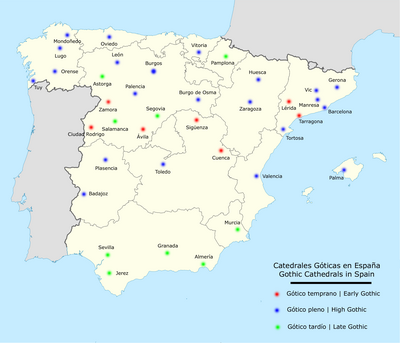Spanish Gothic architecture

Spanish Gothic architecture is the style of architecture prevalent in Spain in the Late Medieval period.
The Gothic style started in Spain as a result of Central European influence in the twelfth century when late Romanesque alternated with few expressions of pure Gothic architecture.[1] The High Gothic arrives with all its strength via the pilgrimage route, the Way of St. James, in the thirteenth century. Some of the most pure Gothic cathedrals in Spain, closest related to the German and French Gothic, were built at this time.
In some cases the Gothic style was built and decorated with Mudéjar elements by Mudéjar craftsmen and Christian craftsmen influenced by them, creating a highly distinctive Gothic style unique to Spain and Portugal. The most important post−thirteenth-century Gothic styles in Spain are the Levantine Gothic, characterized by its structural achievements and the unification of space, and the Isabelline Gothic, under the Catholic Monarchs, that predicated a slow transition to Renaissance architecture. Gothic construction ended in Spain in the sixteenth century.[2]
In 1172, French architect Giral Fruchel designed the first ever Gothic cathedral in Spain.[3] Ávila Cathedral, a cathedral located in Central Spain, represents a blend of the Romanesque and Gothic styles.[4] In 1227, Archbishop Rodrigo Jimenez de Rada initiated the rebuilding of the Toledo Cathedral in the Gothic style as well.[5] Prior to this reconstruction, Toledo was under Muslim control and possessed Islamic architectural elements.[6] Toledo's ground plan, for instance, resembled the ground plan of a mosque.[7] The fusion of Islamic and French Gothic influences gave rise to a distinctive and uniquely Spanish Gothic architectural style, and Toledo Cathedral was among the first to exhibit this.[8]
Sequence of Gothic styles in Spain
[edit]
The designations of styles in Spanish Gothic architecture are as follows. Dates are approximate.
- Early Gothic (12th century)
- High Gothic (13th century)
- Mudéjar Gothic (from the 13th to the 15th centuries)
- Levantino Gothic (14th century)
- Valencian Gothic (14th and 15th century)
- Catalan Gothic
- Flamboyant/Late Gothic (15th century)
- Isabelline Gothic (15th century)
- Plateresque Gothic (15th century)
Examples
[edit]Early Gothic
[edit]- Cathedral of Ávila
- Cathedral of Cuenca
- Cathedral of Sigüenza
- Abbey of Santa María la Real de Las Huelgas in Burgos
High Gothic
[edit]- Cathedral of Burgos
- Cathedral of Burgo de Osma
- Cathedral of León
- Cathedral of Toledo
- Palace of the Kings of Navarre in Olite
- San Pablo Church, Valladolid
Mudéjar Gothic
[edit]Valencian Gothic
[edit]- Valencia Cathedral
- Lonja de la Seda, in Valencia
- Torres de Serranos
- Palace of the Borgias
- Monastery of Sant Jeroni de Cotalba, in Alfauir.
- Monastery of Santa María de la Valldigna, in Simat de la Valldigna.
- Basilica of Santa Maria, in Alicante.
- Orihuela Cathedral, in Orihuela.
- Castelló Cathedral and El Fadrí, in Castellón de la Plana
- Segorbe Cathedral in Segorbe.
Balearic Gothic
[edit]- La Seu (cathedral) of Palma de Mallorca
Catalan Gothic
[edit]- Santa Maria del Mar of Barcelona
- Barcelona Royal Shipyard
- Royal Palace in Barcelona
- Cathedral of Girona
Flamboyant/Late Gothic
[edit]- Cathedral of Oviedo
- Cathedral of Sevilla
- Cathedral of Segovia
- Chapel of the Condestable, Cathedral of Burgos
- New Cathedral in Salamanca
Isabelline Gothic
[edit]- Monastery of San Juan de los Reyes in Toledo
- Royal Chapel of Granada in Granada
- Colegio de San Gregorio in Valladolid
- Palace of Infantado in Guadalajara
- Palace of Jabalquinto in Baeza, Jaén
- San Pablo Church in Valladolid
Modern Spanish Gothic
[edit]Gallery
[edit]-
Church of San Miguel (Jerez de la Frontera), crossing vault
-
St. Peter's Church, Teruel, nave and apse
-
Santa María de la Oliva, nave
-
Santa María de la Oliva, apse
-
Crossing vault of Seville Cathedral by Juan Gil de Hontañón
-
Monastery of Santa María de Huerta, refectory pulpit
See also
[edit]References
[edit]- ^ "Encyclopedia of Medieval Pilgrimage Online". referenceworks. Retrieved 2024-11-19.
- ^ "Khan Academy". www.khanacademy.org. Retrieved 2024-11-19.
- ^ "Ávila Cathedral in Ávila". Spain.info. Retrieved 2024-11-19.
- ^ "Ávila Cathedral in Ávila". Spain.info. Retrieved 2024-11-19.
- ^ "Khan Academy". www.khanacademy.org. Retrieved 2024-11-19.
- ^ Barnes, Carl F. (1978-12-01). "Review: Gothic Architecture by Louis Grodecki, Anne Prache, Roland Recht". Journal of the Society of Architectural Historians. 37 (4): 316–317. doi:10.2307/989265. ISSN 0037-9808. JSTOR 989265.
- ^ "Khan Academy". www.khanacademy.org. Retrieved 2024-11-19.
- ^ Nickson, Tom (2015-12-07). Toledo Cathedral: Building Histories in Medieval Castile. Penn State University Press. doi:10.1515/9780271076638. ISBN 978-0-271-07663-8.


![Church of St John the Baptist, Ágreda [es] in Ágreda, nave](http://upload.wikimedia.org/wikipedia/commons/thumb/6/69/Iglesia_de_San_Juan_Bautista%2C_%C3%81greda%2C_Soria%2C_Espa%C3%B1a%2C_2018-03-29%2C_DD_43-45_HDR.jpg/120px-Iglesia_de_San_Juan_Bautista%2C_%C3%81greda%2C_Soria%2C_Espa%C3%B1a%2C_2018-03-29%2C_DD_43-45_HDR.jpg)
![Church of St Felix, Torralba de Ribota [es] in Torralba de Ribota, altar](http://upload.wikimedia.org/wikipedia/commons/thumb/e/e8/Iglesia_de_San_F%C3%A9lix%2C_Torralba_de_Ribota%2C_Zaragoza%2C_Espa%C3%B1a%2C_2018-04-04%2C_DD_24-26_HDR.jpg/120px-Iglesia_de_San_F%C3%A9lix%2C_Torralba_de_Ribota%2C_Zaragoza%2C_Espa%C3%B1a%2C_2018-04-04%2C_DD_24-26_HDR.jpg)
![Church of St Felix, Torralba de Ribota [es] in Torralba de Ribota, portal](http://upload.wikimedia.org/wikipedia/commons/thumb/f/f4/Iglesia_de_San_F%C3%A9lix%2C_Torralba_de_Ribota%2C_Zaragoza%2C_Espa%C3%B1a%2C_2018-04-04%2C_DD_51-53_HDR.jpg/120px-Iglesia_de_San_F%C3%A9lix%2C_Torralba_de_Ribota%2C_Zaragoza%2C_Espa%C3%B1a%2C_2018-04-04%2C_DD_51-53_HDR.jpg)










